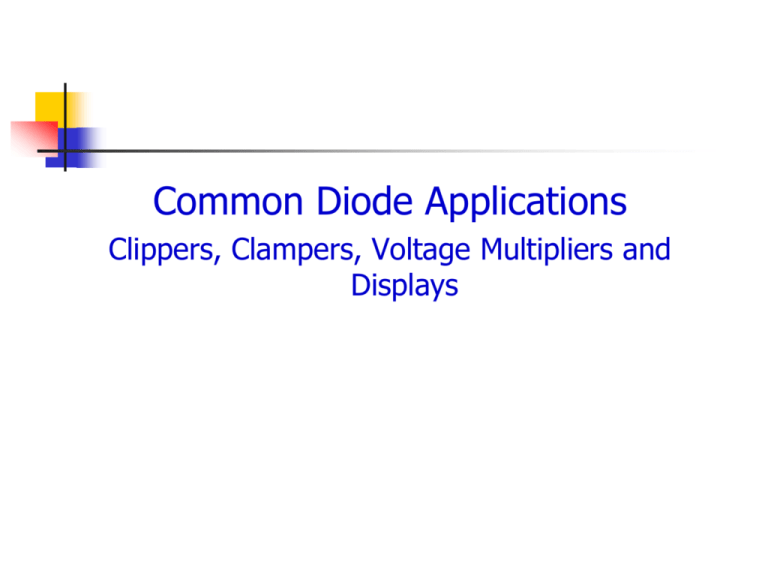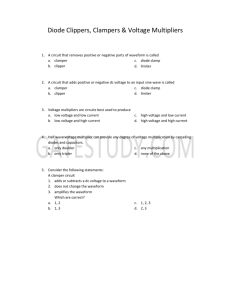Chapter 4 - Ajay Bolar
advertisement

Common Diode Applications Clippers, Clampers, Voltage Multipliers and Displays Diode Clippers A clipper (or limiter) is a circuit used to eliminate some portion (or portions) of a waveform. A series clipper is in series with its load. A shunt clipper is in parallel with its load. Series Clippers Negative Shunt Clipper Operation A Positive Shunt Clipper When the diode is conducting: VL VF When the diode is not conducting: RL VL Vin RL RS Biased Shunt Clippers Diode Clampers A clamper (or dc restorer) sets (or restores) the dc reference of a waveform. Clamper Operation Biased clampers Biased clampers allow a waveform to shifted above or below a dc reference other than 0 V. The dc reference is determined by the biasing voltage (VB) and the setting of the potentiometer (R1). Zener clampers The diodes in (a) are in a common-cathode configuration. The diodes in (b) are in a common-anode configuration. Voltage Doublers A voltage doubler provides an output that is twice its peak input voltage. Half-Wave Voltage Doubler The term “half-wave” reflects the fact that the output capacitor (C2) is charges during one alternation of each input cycle and discharges during the other. Half-Wave Voltage Doubler Operation Full-Wave Voltage Doublers The term “full-wave” reflects the fact that the output capacitors are charged during alternate half-cycles of the input signal. Voltage Tripler A voltage tripler provides a dc output voltage that is approximately three times the peak input voltage. Voltage Quadrupler A voltage quadrupler provides a dc output voltage that is approximately four times the peak input voltage. A Basic Dual-Polarity Power Supply The output voltages are approximately equal to the peak values of the input waveform. LED Level Indicators The LED in circuit (a) lights when the driver output is +5 V. The LED in circuit (b) lights when the driver output is 0 V. Multisegment Display Multisegment display – A device used to display alphanumeric characters (numbers, letters, symbols, and punctuation marks). LED displays contain some number of diodes that are connected in a common-cathode or a common-anode configuration. A liquid crystal display (LCD) consists of segments that reflect (or do not reflect) ambient light when provided an active input. Seven-Segment Displays The display uses LEDs that are arranged in a figure 8 configuration. The display represented below is a common-cathode display. Each LED lights when a positive voltage is applied to the appropriate pin.






